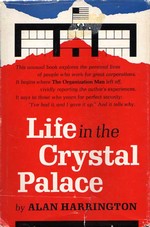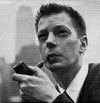 Life in the Crystal Palace
Life in the Crystal Palace may, one day, come to seem a little like one of those prehistoric bugs preserved in resin, as it captures a way of life and work that in many ways has already become a thing of the past.
may, one day, come to seem a little like one of those prehistoric bugs preserved in resin, as it captures a way of life and work that in many ways has already become a thing of the past.
Based on Harrington’s experiences over three years working in the public relations department at the headquarters of an unnamed firm–one of the largest in America at the time, with over 34,000 employees worldwide–the book is almost an anthropological study of mid-fifties corporation life. This is the real-life equivalent of the World Wide Wicket Company of “How to Succeed in Business Without Really Trying”.
Harrington saw that corporate employee as a new species, one that “may be distinguished from other American working people at least in one way, by an absence of nervousness.” This was the era when people could join a company and talk about having “a job for life”
Life is good, life is gentle. Barring a deep depression or war, we need never worry about money again. We will never have to go job-hunting again. We may get ahead at different speeds, and some will climb a bit higher than others, but whatever happens the future is as secure as it can be. And the test is not arduous. Unless for some obscure reason we choose to escape back into your anxious world (where the competition is so hard and pitiless and your ego is constantly under attack) we will each enjoy a comfortable journey to what our house organ calls “green pastures,” which is, of course, retirement.
Harrington joined the Crystal Palace, as he calls the firm in the book, just before it moves into its new headquarters in the suburbs outside New York City–“a fabulous place–a great office-palace on a hilltop surrounded by fields and woodlands.” There, he worked on advertising campaigns, promotional films, and other publicity.
He calls himself a “poodle of journalism” for his work on the company’s monthly newsletter, the Palace Voice:
Nearly every big company has a paper of some kind, and it is certainly reasonable that such publications exist. But why must they be so dull? The answer to that is easy: because they mustn’t contain the smallest hint of controversy or present any idea that is not pleasing and soothing–“all the news that’s print to fit.” Every story in the Voice has to be checked by higher authority to make sure that it is free of roughage. In the end, therefore, the house organ is like the food in the dining hall–smooth, bland, and creamy.
It’s really just a polite form of propaganda, Harrington concludes, closer to Pravda than The New York Times.
Like the Communist Party at its height, Harrington’s corporation wants its members (employees) to believe: “Like the Church, my Crystal Palace removes the burden of belief from me. It removes my need for decision. I have found my rock. I believe only in the company.” And like in the Party, success is less a matter of talent than of learning how to succeed at the organization’s game:
What cannot be learned that quickly is the corporation minuet–the respectful dance with the right partners. The watchful corporation man gradually finds out who is important and who is not; what is acceptable and what is not; what type of project will advance his fortunes and what is not worth bothering about. Experience for him mainly adds up to learning how to behave. The secrets of gaging and responding to the power of others–superimposed on a normal intelligence–will move him slowly upward.
Even though “job for life” corporations started fading from the scene like dinosaurs in the recessions of the 1970s, 1980s, and 1990s, some of Harrington’s observations still ring true for anyone who’s worked in a white-collar organization. Like his assessment of the job of administrators: “After watching scores of them in action, I could swear that their duties consist mainly of frowning over sheets of paper, consulting with others, and then passing on the job-to-be-done to a specialist.”
Or his definition of the disgruntled employee, or “incomplete rebel”, as he calls him: “The incomplete rebel is someone who resents his situation but can’t find the means to improve it.” Or of daily lunch with co-workers:
When we first moved to the Palace a general memorandum (abetted by the Voice) encouraged headquarters personnel to mingle in the dining hall and get to know each other. The idea was that you should not necessarily eat with members of your own department, but sit with people doing other kinds of work. This suggestion has largely been ignored. We eat with about the same companions day after day. The result is to pile incestuousness on incestuousness, and our lunch conversations are for the most part, again, as bland and creamy as our food. I do not mean to say that we are duller than anybody else, but try lunching with the same group day after day. Conversation becomes a sort of filler, a means of avoiding silence.
Even at the height of the great, sheltering corporation, there were signs that this kind of artificial world could not last:
Corporate practices involve a fundamental inconsistency. Management wants simultaneously (a) performance from everyone and (b) protection for everyone. But the impulse to perform and the impulse to protect yourself cannot exist as equals. One must gain ascendancy over the other. To perform, move, swing, the self goes out and takes chances. The reflex of self-protection produces subservience to the group, a willingness to spread responsibility until it doesn’t exist, a binding horror of chance-taking and obseisance to the system. How can these two drives exist together in equal strength?
 Late in his time at the Crystal Palace, Harrington prepares a number of suggestions aimed at injecting a stronger sense of accountability into the company’s way of working, but then tosses them aside, recognizing they had no chance of being adopted. He had become, in his own words, “a thoroughly tamed playboy.” “Spiritually, my net worth was zero.” Only a lucky offer from Cary McWilliams, editor of The Nation, to write about his experiences finally offers him a way out. The article, and a grant from the Fund for the Republic, led to this book.
Late in his time at the Crystal Palace, Harrington prepares a number of suggestions aimed at injecting a stronger sense of accountability into the company’s way of working, but then tosses them aside, recognizing they had no chance of being adopted. He had become, in his own words, “a thoroughly tamed playboy.” “Spiritually, my net worth was zero.” Only a lucky offer from Cary McWilliams, editor of The Nation, to write about his experiences finally offers him a way out. The article, and a grant from the Fund for the Republic, led to this book.
Life in the Crystal Palace is not the only book by Alan Harrington worth rediscovering. It’s remarkable, in fact, that he managed to survive three years in the Crystal Palace, since much of his oeuvre reflects a man who consistently approached life from a unique angle:
is not the only book by Alan Harrington worth rediscovering. It’s remarkable, in fact, that he managed to survive three years in the Crystal Palace, since much of his oeuvre reflects a man who consistently approached life from a unique angle:
- • Revelations of Dr. Modesto

- His first book and novel, which is a sharp, satiric poke at the conformist nature of American life in the 1950s. Dr. Modesto’s revelations are that conforming, taken literally and to the extreme, in fact, is the one true path to happiness.
- • The Immortalist

- “Death is an imposition on the human race, and no longer acceptable.” Harrington takes this implausible premise as the basis for an essay on the large and necessary role that death plays in human live.
- • Psychopaths

- Again, Harrington takes an irony view of the misfit in society: “Drunkards and forgers, addicts, flower children . . . Mafia loan shark battering his victim, charming actor, murderer, nomadic guitarist, hustling politician, the saint who lies down in front of tractors, the icily dominating Nobel Prize winner stealing credit from laboratory assistants . . . all, all doing their thing” and sees them as new men, model characters rather than rejects.
- • The White Rainbow

- His last novel, about two characters Benjamin DeMott described as a ”rich, leukemia-battling, Yankee-hating Mexican radicalized at Columbia in the Mark Rudd days” and ”Harvard’s wunderkind in his mid-30’s, gifted linguist, man of Viking beauty.” The New Times Book Review picked it as one of the notable books of 1981.
Find a Copy
Life in the Crystal Palace, by Alan Harrington
New York: Alfred A. Knopf, 1959

, is out of print now. In some ways, it’s a classic text of the 1950s, a satire on normality written in the middle of what, in America at least, may have been normality’s greatest decade.
under the name of Hal Hingham.
over thirty years ago, and since then, have carried a memory of it as a magical little book, something along the lines of Michael Frayn’s Sweet Dreams. On re-reading the book recently, however, I found it disjointed and often flat, with none of the charm of Frayn’s fantasy and not enough of the sharp edge required for satire. Ironically, Harrington tends to treat his characters with too much empathy to skewer them with sufficient cold-bloodedness. I wonder now if I was remembering the wrong book.


 Late in his time at the Crystal Palace, Harrington prepares a number of suggestions aimed at injecting a stronger sense of accountability into the company’s way of working, but then tosses them aside, recognizing they had no chance of being adopted. He had become, in his own words, “a thoroughly tamed playboy.” “Spiritually, my net worth was zero.” Only a lucky offer from Cary McWilliams, editor of The Nation, to write about his experiences finally offers him a way out. The article, and a grant from the
Late in his time at the Crystal Palace, Harrington prepares a number of suggestions aimed at injecting a stronger sense of accountability into the company’s way of working, but then tosses them aside, recognizing they had no chance of being adopted. He had become, in his own words, “a thoroughly tamed playboy.” “Spiritually, my net worth was zero.” Only a lucky offer from Cary McWilliams, editor of The Nation, to write about his experiences finally offers him a way out. The article, and a grant from the